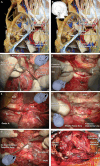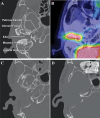Clinical Analysis of En Bloc Resection for Advanced Temporal Bone Squamous Cell Carcinoma
- PMID: 35832936
- PMCID: PMC9272235
- DOI: 10.1055/s-0041-1722930
Clinical Analysis of En Bloc Resection for Advanced Temporal Bone Squamous Cell Carcinoma
Abstract
Objective En bloc and margin-negative surgical resection seems to offer the best prognosis for patients with temporal bone squamous cell carcinoma (TB-SCC). In this study, we summarize the outcomes of surgical cases of advanced TB-SCC (T3-T4) that were managed in two institutions, with an accompanying description of the surgical procedure that was utilized: modified subtotal temporal bone resection (STBR), which involves the en bloc removal of the temporal bone including or transecting the otic capsule. Design This is a case series study with chart review. Setting The study was conducted at two academic tertiary care medical centers. Participants Chart information was collected for all patients who underwent surgical resection of advanced TB-SCC between July 1998 and February 2019. The resulting dataset contained 43 patients with advanced TB-SCC who underwent en bloc resection during the review period. Tumor staging followed the modified Pittsburgh classification. Disease-specific survival (DSS) rates were calculated according to the Kaplan-Meier method. Main Outcome Measure This study shows disease-specific 5-year DSS rate. Results The 5-year DSS rate of the cases who underwent en bloc resection was 79.7%. En bloc lateral temporal bone resection was employed in a total of 25 cases (DSS: 79.0%). En bloc modified STBR was utilized in 18 cases (DSS: 81.7%). Conclusion En bloc margin-negative resection is a reliable treatment strategy for advanced TB-SCC. Modified STBR can be a treatment option for TB-SCC without marked posterior extension.
Keywords: skull base; squamous cell carcinoma; subtotal temporal bone resection; temporal bone.
Thieme. All rights reserved.
Conflict of interest statement
Conflict of Interest None declared.
Figures



References
-
- Mazzoni A, Zanoletti E, Marioni G, Martini A. En bloc temporal bone resections in squamous cell carcinoma of the ear. Technique, principles, and limits. Acta Otolaryngol. 2016;136(05):425–432. - PubMed
-
- Conley J J, Novack A J. The surgical treatment of malignant tumors of the ear and temporal bone. Part I. AMA Arch Otolaryngol. 1960;71:635–652. - PubMed
-
- Jimbo H, Kamata S, Miura K et al.En bloc temporal bone resection using a diamond threadwire saw for malignant tumors. J Neurosurg. 2011;114(05):1386–1389. - PubMed
-
- Parsons H, Lewis J S. Subtotal resection of the temporal bone for cancer of the ear. Cancer. 1954;7(05):995–1001. - PubMed
LinkOut - more resources
Full Text Sources
Research Materials

